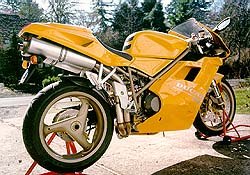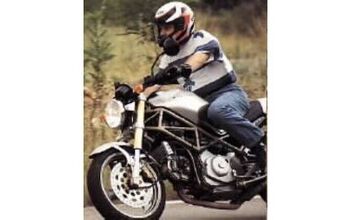First Impression: 1997 Ducati 748 - Motorcycle.com
A 916 For the Masses?
To the joy of American riders, Ducati has finally decided to import the 748. Considered a baby brother to the 916, Ducati's 748 has been the darling of the European motorcycling press since its introduction. Basically a smaller-displacement version of the 916, the 748 trades off torque and low-end grunt for a higher rev limit through tricks like a lightened flywheel.
The 748 made a surprise debut at the International Bike Show this year - Ducati showed up with one screaming-yellow single-seater, a price tag, and that's it. No brochures, no specs, but promises to deliver 200 copies to the States starting at the end of January. Only the solo seat version would be coming here, they said.
But remember, we're dealing with an Italian motorcycle company. The bikes did arrive on time, amazingly enough, but other features like owner's manuals, shop manuals, warranty cards and so forth are apparently arriving "under separate cover." Interestingly my local dealer, Salem Honda/BMW/Ducati, opened the crate to find not a solo version, but a Biposto. Today's story from Bologna is that 40 of the promised 200 748s will be Bipostos.
Both versions are solid "I can't believe it's not butter" yellow, but the Biposto forgoes the single-seater's white pseudo-number plate tail section, instead having a vinyl passenger seat dyed yellow to match the rest of the tail, which it does surprisingly well. The wheels, like the frame, are a bronze/gold color. Not only do they look great in combination with the yellow paint, but more importantly, they hide brake dust and road grime well. If you've ever owned a bike with white wheels, you'll know what we mean.
Although this bike is gorgeous, a careful inspection reminds you that it's definitely not a Honda or a Suzuki. A close look at the painted bodywork reveals a substantial amount of orange peel -- but nothing you'd notice unless your eyes were six inches away, waxing it under bright lights late at night in your garage (sigh). The neutral light indicates you might be somewhere near neutral, so you have to carefully feed out the clutch if you think you're there. And just because the neutral light isn't on, you can't assume you're in gear.
Although hydraulic, clutch effort requires the Jaws of Life. Also, brake feel is on the spongy side, but switching to braided steel lines made a phenomenal difference. The rear brake is pretty much ornamental. There's no fear of locking it up, even if you did something as unholy as ride this bike in the rain. It merely serves to settle the suspension slightly, and to keep the bike from rolling backwards from a stoplight on a slight hill.
Gas mileage is pretty good, producing about 100 miles in around-town driving before the low fuel light comes on, indicating one gallon left of 4.5 gallons. Weight of Ducati's 748 is just over 400 pounds, but feels much lighter.
The little Duck is an absolute blast to ride. Hell, it's a blast just to sit on at stoplights, ripping the throttle open, pretending to be checking some adjustment in the engine. I want to ride it through the store when I get my groceries. I want to widen my front door, and build a ramp so I can park it in my living room (hey, it doesn't leak oil). Get rid of that new car you bought, buy an old beater for those rainy days, and spend that car payment on one of these demons instead.
Specifications
Manufacturer: DucatiModel: 1997 748Price: ,995Engine: 4-stroke, 90-degree V-TwinBore x stroke: 88mm by 61.5mmDisplacement: 748ccCarburetion: Weber fuel injectionTransmission: 6 speedWheelbase: 55.5 in.Seat height: 31.1 in.Fuel capacity: 4.6 gal.Claimed dry weight: 440lbs
More by Michael Cottam





































Comments
Join the conversation